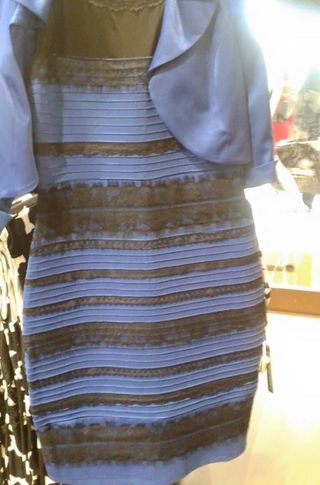White and Blue Two Piece Prom Dress Johnnie and
Science of 'the Dress': Why We Confuse White & Gold with Blue & Black

Remember "The Dress" — the photograph that sparked an online firestorm about whether the garment was white and gold or blue and black? Now, researchers have studied the phenomenon scientifically.
Their findings, detailed on May 14 in the journal Current Biology, suggest the difference in perceived color has to do with how the brain perceives colors in daylight.
It's been well-documented that people can see shapes and colors differently, but "the dress" is perhaps one of the most dramatic examples of a difference in color perception, the researchers said. [Eye Tricks: A Gallery of Visual Illusions]
"By studying the pair of colors in 'The Dress,' we can answer the age-old question: Do you see colors the way that I see them? And the answer is sometimes 'no,'" Bevil Conway, a neuroscientist who teaches at Wellesley College and the Massachusetts Institute of Technology, said in a statement.
But until now, the effect had not been documented scientifically.
Color constancy
In one study, Conway and his colleagues asked 1,401 people (313 of whom had never seen the image of the dress before) what color they thought the garment was. Of those surveyed, 57 percent described the dress as blue/black, 30 percent described it as white/gold, 11 percent as blue/brown and 2 percent as something else. Some people reported their perception of the colors flipped after being tested again.
According to Conway's team, the differences in color perception are probably due to assumptions the brain makes about the illumination of the garment so that it will appear the same under different lighting, a property known as color constancy.
People who saw the dress as a white-gold color probably assumed it was lit by daylight, so their brains ignored shorter, bluer wavelengths. Those who saw it as a blue-black shade assumed a warm, artificial light, so their brains ignored longer, redder wavelengths. Those who saw the dress as a blue-brown color probably assumed neutral lighting, the researchers said.
Interestingly, older people and women were more likely to see the dress as white and gold, as opposed to blue and black. This could be because older people and women may be more likely to be active during the day, while younger people and men may be more likely to spend time around artificial light sources, the researchers said.
Daylight vs. artificial light
Another group of researchers, at Giessen University in Germany and the University of Bradford in England, showed the dress to 15 people on a well-calibrated screen under controlled lighting, and had them adjust the color of a disc on the screen so it matched that of the dress and its trim.
Rather than seeing the color of the dress itself as either white or blue with gold or black trim, the participants reported seeing a spectrum of shades from light blue to dark blue, with yellow/gold to dark brown/black trim, the researchers found. Nonetheless, when the dress color was a certain brightness, the participants deemed it "white," and when it was below that brightness, they called it "blue."
The researchers found that the colors people reported are the same colors found in daylight — which tends to be bluish at noon and yellowish at dawn or dusk — in agreement with Conway's team. As such, the phenomenon would not have happened if the dress had been red, they said.
A new property of color
A third study, conducted by researchers at the University of Nevada, Reno, recruited 87 college students and asked them to name the colors of the dress. About the same number of participants reported seeing it as white/gold as blue/black (a small percentage saw different colors).
Then, the researchers inverted the image so that the lighter stripes appeared gold and the darker stripes appeared blue. Now, nearly 95 percent of the participants reported seeing the lighter stripes as "vivid yellow." The researchers confirmed these findings in another group of 80 participants.
"We discovered a novel property of color perception and constancy, involving how we experience shades of blue versus yellow," the researchers wrote in the study.
People are much more likely to perceive a surface as white or gray if the amount of blue varies, compared with similar changes in the amount of yellow, red or green, they added.
Follow Tanya Lewis on Twitter . Follow us @livescience , Facebook & Google+ . Original article on Live Science.
Source: https://www.livescience.com/50842-dress-debate-color-perception.html
0 Response to "White and Blue Two Piece Prom Dress Johnnie and"
Post a Comment